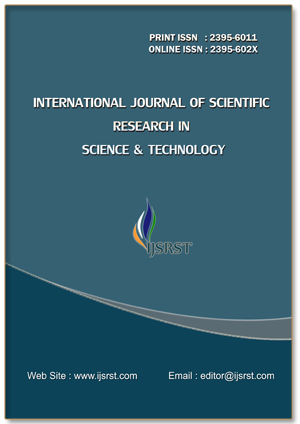The Potential of Stem Cell Therapy in Regenerative Medicine and Injury Recovery
DOI:
https://doi.org/10.32628/IJSRST25121190Keywords:
Mesenchymal Stem Cells, Exosomes, Wound Healing, Regenerative Medicine, Immune ModulationAbstract
Synthetic molecules derived from mesenchymal stem cells (MSCs) and from MSC-derived exosomes show promise as regenerative potential for tissue repair and wound healing. MSCs are multipotent and can differentiate into different cell types, the effect of which is enhanced through exosomes, via paracrine signalling. Guillamat-Prats (2021) concludes recent studies have shown that MSCs can accelerate wound healing by up to 50% compared to control groups, and that MSC derived exosomes have doubled cellular migration and collagen deposition in vitro. Additionally, MSC therapies have been able to dramatically decrease inflammatory cytokines like TNFα and IL6 by up to 40%, leading to a more environmentally favorable healing milieu (Lee et al., 2023). The aim of this study is to investigate the effects of MSC and MSC derived exosome treatments on wound healing, specifically enhanced regenerative properties and immune modulation of MSC exosomes. Although results were subjective, histological analysis showed that the highest improvement in wound closure was achieved with MSC+Exosome treatments, which healed over 95% after 14 days, while control groups healed 60%. Finally, the study demonstrates the utility of exosome based delivery systems for targeted, efficient and off target effect free tissue repair. The results are encouraging, but there are still challenges, including scalability and immune rejection, and future research will be aimed at improving the isolation of exosomes and studying MSC based therapies for chronic wound management, cartilage regeneration and neurodegenerative disease.
Downloads
References
R. Margiana, A. Markov, A. O. Zekiy, M. U. Hamza, K. A. Al-Dabbagh, S. H. Al-Zubaidi, ... & H. Siahmansouri, “Clinical application of mesenchymal stem cell in regenerative medicine: a narrative review,” Stem Cell Research & Therapy, vol. 13, no. 1, p. 366, 2022. DOI: https://doi.org/10.1186/s13287-022-03054-0
V. Miceli, M. Bulati, G. Iannolo, G. Zito, A. Gallo, and P. G. Conaldi, “Therapeutic properties of mesenchymal stromal/stem cells: the need of cell priming for cell-free therapies in regenerative medicine,” International Journal of Molecular Sciences, vol. 22, no. 2, p. 763, 2021. DOI: https://doi.org/10.3390/ijms22020763
R. Guillamat-Prats, “The role of MSC in wound healing, scarring and regeneration,” Cells, vol. 10, no. 7, p. 1729, 2021. DOI: https://doi.org/10.3390/cells10071729
M. D. Hade, C. N. Suire, and Z. Suo, “Mesenchymal stem cell-derived exosomes: applications in regenerative medicine,” Cells, vol. 10, no. 8, p. 1959, 2021. DOI: https://doi.org/10.3390/cells10081959
M. A. H. Abusalah, E. N. S. E. Abd Rahman, and O. P. Choudhary, “Evolving trends in stem cell therapy: an emerging and promising approach against various diseases,” International Journal of Surgery, vol. 110, no. 11, pp. 6862-6868, 2024. DOI: https://doi.org/10.1097/JS9.0000000000001948
C. R. Harrell, V. Djonov, and V. Volarevic, “The cross-talk between mesenchymal stem cells and immune cells in tissue repair and regeneration,” International Journal of Molecular Sciences, vol. 22, no. 5, p. 2472, 2021. DOI: https://doi.org/10.3390/ijms22052472
Regenerative Medicine and Stem Cell Biology, Germany: Springer International Publishing, 2020.
J. H. Lee, Y. J. Won, H. Kim, M. Choi, E. Lee, B. Ryoou, ... & B. S. Cho, “Adipose tissue-derived mesenchymal stem cell-derived exosomes promote wound healing and tissue regeneration,” International Journal of Molecular Sciences, vol. 24, no. 13, p. 10434, 2023. DOI: https://doi.org/10.3390/ijms241310434
X. Xu, L. Xu, J. Xia, C. Wen, Y. Liang, and Y. Zhang, “Harnessing knee joint resident mesenchymal stem cells in cartilage tissue engineering,” Acta Biomaterialia, vol. 154, pp. 1-12, 2023. DOI: https://doi.org/10.2139/ssrn.4385050
A. Casado-Díaz, J. M. Quesada-Gómez, and G. Dorado, “Extracellular vesicles derived from mesenchymal stem cells (MSC) in regenerative medicine: applications in skin wound healing,” Frontiers in Bioengineering and Biotechnology, vol. 8, p. 146, 2020. DOI: https://doi.org/10.3389/fbioe.2020.00146
V. J. Costela-Ruiz, L. Melguizo-Rodríguez, C. Bellotti, R. Illescas-Montes, D. Stanco, C. R. Arciola, and E. Lucarelli, “Different sources of mesenchymal stem cells for tissue regeneration: a guide to identifying the most favorable one in orthopedics and dentistry applications,” International Journal of Molecular Sciences, vol. 23, no. 11, p. 6356, 2022. DOI: https://doi.org/10.3390/ijms23116356
H. Han, B. T. Chen, Y. Liu, Y. Wang, L. Xing, H. Wang, ... & H. L. Jiang, “Engineered stem cell-based strategy: A new paradigm of next-generation stem cell product in regenerative medicine,” Journal of Controlled Release, vol. 365, pp. 981-1003, 2024. DOI: https://doi.org/10.1016/j.jconrel.2023.12.024
Scientific Principles of Adipose Stem Cells, Netherlands: Academic Press, 2021.
F. Sivandzade and L. Cucullo, “Regenerative stem cell therapy for neurodegenerative diseases: an overview,” International Journal of Molecular Sciences, vol. 22, no. 4, p. 2153, 2021. DOI: https://doi.org/10.3390/ijms22042153
M. Maqsood, M. Kang, X. Wu, J. Chen, L. Teng, and L. Qiu, “Adult mesenchymal stem cells and their exosomes: Sources, characteristics, and application in regenerative medicine,” Life Sciences, vol. 256, p. 118002, 2020. DOI: https://doi.org/10.1016/j.lfs.2020.118002
V. Börger, S. Staubach, R. Dittrich, O. Stambouli, and B. Giebel, “Scaled isolation of mesenchymal stem/stromal cell‐derived extracellular vesicles,” Current Protocols in Stem Cell Biology, vol. 55, no. 1, p. e128, 2020. DOI: https://doi.org/10.1002/cpsc.128
Stem Cells and Regenerative Medicine, Singapore: World Scientific, 2008.
S. Silvestro, P. Bramanti, O. Trubiani, and E. Mazzon, “Stem cells therapy for spinal cord injury: an overview of clinical trials,” International Journal of Molecular Sciences, vol. 21, no. 2, p. 659, 2020. DOI: https://doi.org/10.3390/ijms21020659
L. L. Liau, Q. H. Looi, W. C. Chia, T. Subramaniam, M. H. Ng, and J. X. Law, “Treatment of spinal cord injury with mesenchymal stem cells,” Cell & Bioscience, vol. 10, p. 1-17, 2020. DOI: https://doi.org/10.1186/s13578-020-00475-3
A. Kourgiantaki, D. S. Tzeranis, K. Karali, K. Georgelou, E. Bampoula, S. Psilodimitrakopoulos, ... & A. Gravanis, “Neural stem cell delivery via porous collagen scaffolds promotes neuronal differentiation and locomotion recovery in spinal cord injury,” NPJ Regenerative Medicine, vol. 5, no. 1, p. 12, 2020. DOI: https://doi.org/10.1038/s41536-020-0097-0
Downloads
Published
Issue
Section
License
Copyright (c) 2025 International Journal of Scientific Research in Science and Technology

This work is licensed under a Creative Commons Attribution 4.0 International License.
https://creativecommons.org/licenses/by/4.0





